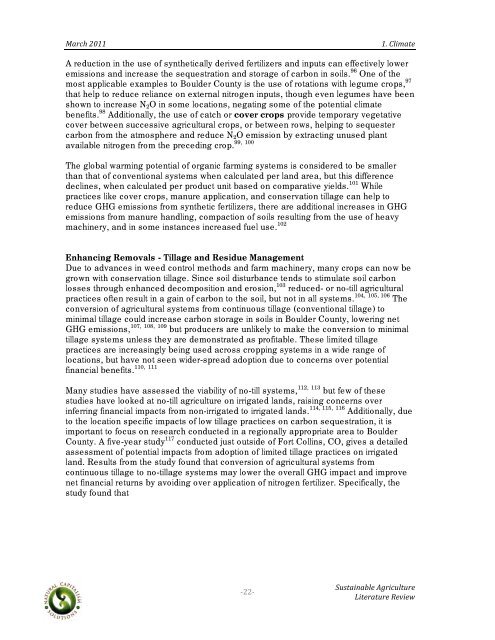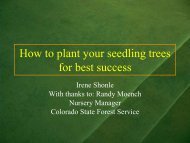Sustainable Agriculture Literature Review - Boulder County
Sustainable Agriculture Literature Review - Boulder County
Sustainable Agriculture Literature Review - Boulder County
Create successful ePaper yourself
Turn your PDF publications into a flip-book with our unique Google optimized e-Paper software.
! ! !!<br />
"#$%&!'())! !!!!!!!!!!!!!!!!!!!!!!!!!!!!!!!!!!!!!!!!!!!!!!!!!! )=!>1.;#-2!<br />
A reduction in the use of synthetically derived fertilizers and inputs can effectively lower<br />
emissions and increase the sequestration and storage of carbon in soils. 96 One of the<br />
most applicable examples to <strong>Boulder</strong> <strong>County</strong> is the use of rotations with legume crops, 97<br />
that help to reduce reliance on external nitrogen inputs, though even legumes have been<br />
shown to increase N2O in some locations, negating some of the potential climate<br />
benefits. 98 Additionally, the use of catch or cover crops provide temporary vegetative<br />
cover between successive agricultural crops, or between rows, helping to sequester<br />
carbon from the atmosphere and reduce N2O emission by extracting unused plant<br />
99, 100<br />
available nitrogen from the preceding crop.<br />
The global warming potential of organic farming systems is considered to be smaller<br />
than that of conventional systems when calculated per land area, but this difference<br />
declines, when calculated per product unit based on comparative yields. 101 While<br />
practices like cover crops, manure application, and conservation tillage can help to<br />
reduce GHG emissions from synthetic fertilizers, there are additional increases in GHG<br />
emissions from manure handling, compaction of soils resulting from the use of heavy<br />
machinery, and in some instances increased fuel use. 102<br />
Enhancing Removals - Tillage and Residue Management<br />
Due to advances in weed control methods and farm machinery, many crops can now be<br />
grown with conservation tillage. Since soil disturbance tends to stimulate soil carbon<br />
losses through enhanced decomposition and erosion, 103 reduced- or no-till agricultural<br />
practices often result in a gain of carbon to the soil, but not in all systems. 104, 105, 106 The<br />
conversion of agricultural systems from continuous tillage (conventional tillage) to<br />
minimal tillage could increase carbon storage in soils in <strong>Boulder</strong> <strong>County</strong>, lowering net<br />
GHG emissions, 107, 108, 109 but producers are unlikely to make the conversion to minimal<br />
tillage systems unless they are demonstrated as profitable. These limited tillage<br />
practices are increasingly being used across cropping systems in a wide range of<br />
locations, but have not seen wider-spread adoption due to concerns over potential<br />
110, 111<br />
financial benefits.<br />
Many studies have assessed the viability of no-till systems, 112, 113 but few of these<br />
studies have looked at no-till agriculture on irrigated lands, raising concerns over<br />
inferring financial impacts from non-irrigated to irrigated lands. 114, 115, 116 Additionally, due<br />
to the location specific impacts of low tillage practices on carbon sequestration, it is<br />
important to focus on research conducted in a regionally appropriate area to <strong>Boulder</strong><br />
<strong>County</strong>. A five-year study 117 conducted just outside of Fort Collins, CO, gives a detailed<br />
assessment of potential impacts from adoption of limited tillage practices on irrigated<br />
land. Results from the study found that conversion of agricultural systems from<br />
continuous tillage to no-tillage systems may lower the overall GHG impact and improve<br />
net financial returns by avoiding over application of nitrogen fertilizer. Specifically, the<br />
study found that<br />
!<br />
"##"<br />
!*+,-#./#012!34$.%+1-+$2!<br />
5.-2$#-+$2!627.28!
















